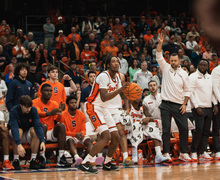Even in football, bigger isn’t always better. Josh Thomas learned the hard way.
When he gets the chance, Josh Thomas likes to sit at his laptop and dabble with creative fiction.
If he stopped for a second and looked at the face staring back from his screen, he’d realize his own career – one of irony, plot twists and untold potential – would make for quite a tale.
Thomas, a senior who came to Syracuse with much hype, broke out as a sophomore only to see his numbers shrink last season because of excessive weight. Now, after recovering from an injured foot and losing nearly 30 pounds this offseason, Thomas feels he’s prepared to pen a fitting conclusion.
‘It’s great to start over, be healthy, about 30 pounds lighter,’ Thomas said. ‘I just feel healthier. It’s great to get the start of a camp that I kind of wanted last year.’
Syracuse coaches saw the way Josh Thomas disrupted backfields two years ago as a sophomore on his way to 46 tackles, and their mouths salivated. Thomas is the prototype for a defensive end – 6-foot-7, sturdier than an oak.
They made plans for him. Big plans. He would be Dwight Freeney in a tackle’s body, fast enough to chase down quarterbacks, yet large enough to clog running holes. Thomas obliged. He assaulted the weight room, and every set, every rep was done for a sole purpose – getting to 300 pounds.
It worked. Thomas reached 300, and then some, before last season. His junior year, Thomas would be unstoppable. Heck, those extra pounds couldn’t even keep his 40-yard-sprint time from shrinking.
He was bigger. Faster. Stronger. Worse.
No matter the faster 40 time, the extra weight hindered Thomas’ agility. He injured his foot against North Carolina, SU’s second game of the season, and missed two games. At season’s end, Thomas had registered just 33 tackles. After his sophomore season, the year was an anticlimax.
‘Looking back last year, I think our goals were kind of messed up,’ Thomas said. ‘I was focused more on gaining the weight and being big than playing football and moving around. We kind of overlooked some things. We had a different plan for me last year and it just didn’t pan out.’
Syracuse wanted Thomas to play the three technique, meaning he would play just off the offensive tackle’s inside shoulder rather than his outside. His main purpose would be stopping the run, not rushing the passer.
‘That never panned out,’ Thomas said. ‘As a team, we never went that route. It was too late to change.’
‘I think it was a mistake on my part to have him gain weight,’ head coach Paul Pasqualoni said.
With his cumbersome new body, Thomas couldn’t explode off the ball. He could run faster over 40 yards, but not 10. He couldn’t afford it.
‘As a defensive end you often have to change direction,’ Pasqualoni said. ‘Here’s your life: Close everything off to the inside, and as fast as you can, fight back to the outside. That’s what you spend your whole life doing as a defensive end.’
Now, Thomas is better suited to do that. He’s down to 282 pounds after spending the offseason doing agility and pass-rushing drills with his defensive linemates.
‘I see his change of direction and his quickness,’ Pasqualoni said. ‘He’s much better. Much less stress in the lower body. He can change direction better and fill the role of a defensive end.’
This year, that role means piling up sacks. The Carrier Dome was so inviting for quarterbacks last season the carpet-like turf should have been painted red. Much of the blame fell on the secondary, which rendered a national-worst 304 passing yards per game.
But opposing quarterbacks usually found ample time to pick apart that unit. Syracuse made 26 sacks last year, and eight of those came against 1-11 Rutgers in a 45-14 victory.
Those numbers figure to improve. Tackles Louis Gachelin and Christian Ferrara shed pounds, too.
‘Last year we were heavy,’ Gachelin said. ‘We were in shape, but not in the shape that we all wanted to be in, and I think that’s what caused a lot of injuries. This year, we’re lean, we’re running, we’re just ready to go.’
‘(The pass rush) is something we’ve really focused on during the winter program,’ Thomas said. ‘We focused on speed and just working on our pass rush. We knew that was something we had to improve.’
Of course, Thomas will jump at the chance to improve. Every writer knows a first draft can always use revision.
Published on August 27, 2003 at 12:00 pm





